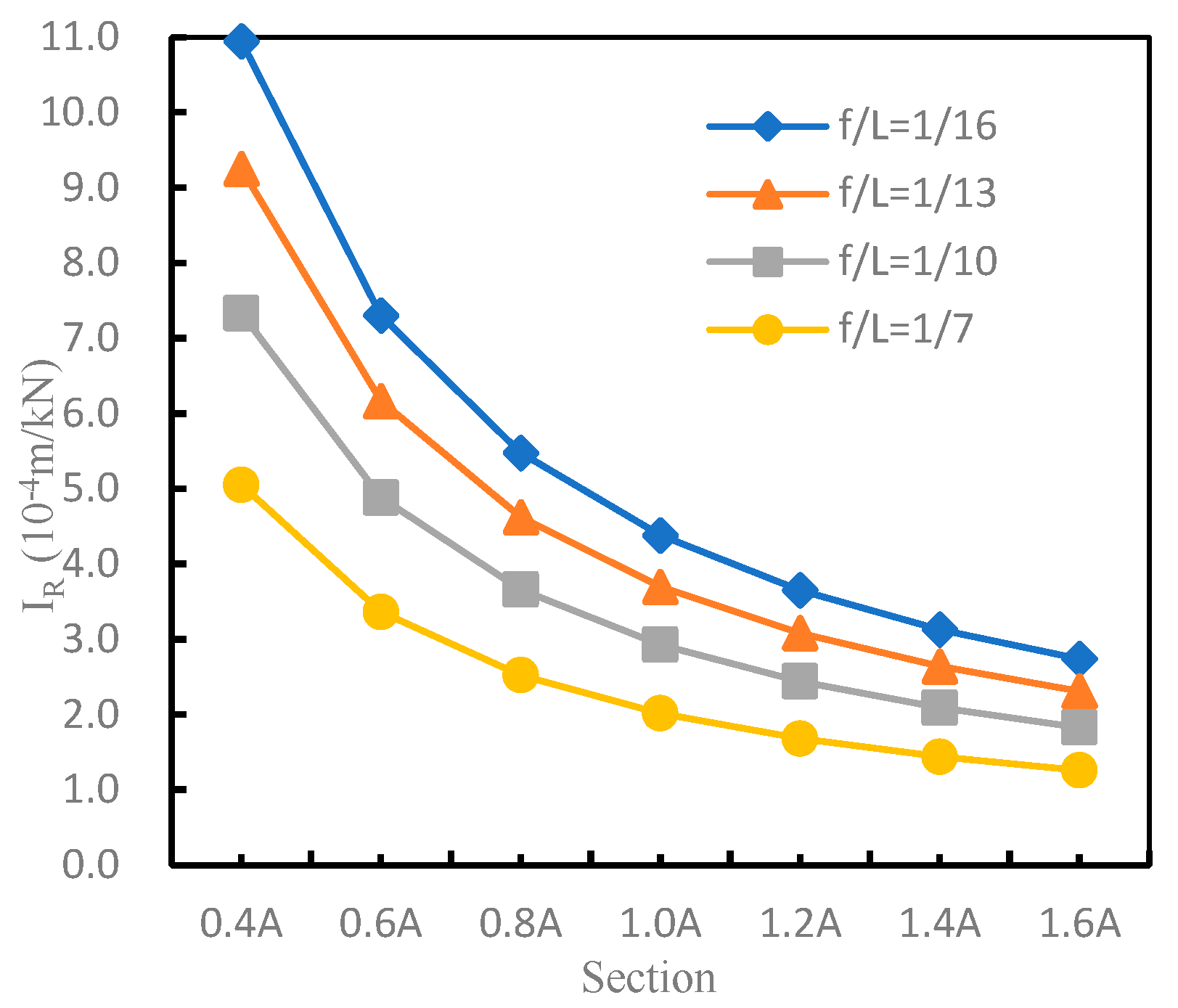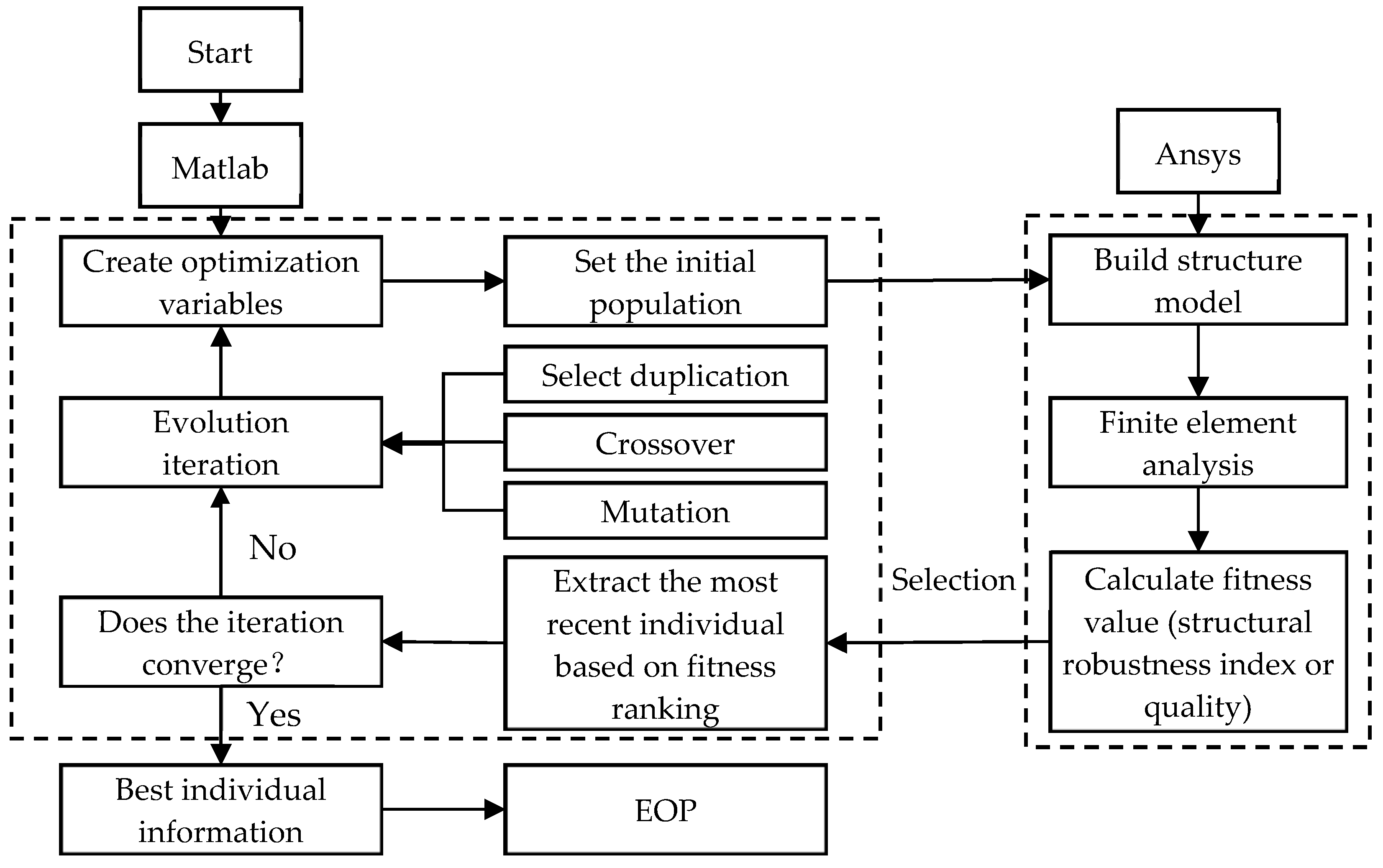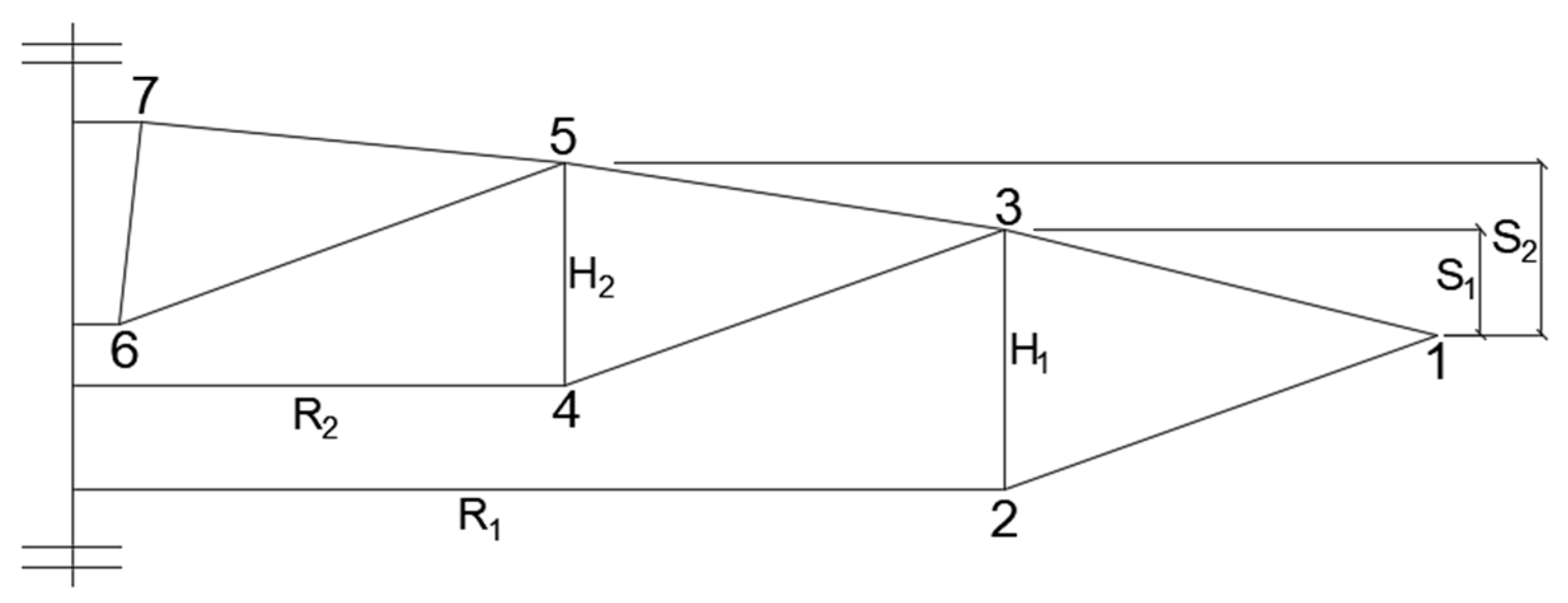Design Optimisation for Cable Dome Structures Based on Progressive Collapse Resistance
Abstract
:1. Introduction
2. Fundamental Theory of Nonlinear Structural Robustness
3. Case Study of Robust Parameter Analysis of a Cable Dome Structure
3.1. Analysis of the Effects of Element Cross-Sectional Area and Structural Span on Structural Robustness
3.2. Analysis of the Effects of Rise-to-Span Ratio on Structural Robustness
4. Robustness-Based Optimal Design
- (1)
- The optimisation parameters were set in MATLAB, namely, the population size, encoding string length, crossover and mutation probability, and number of evolutionary iterations. The population size was set as 40, the encoding string length was set as 52, the crossover probability was set as 0.8, the mutation probability was set as 0.2, and the number of evolutionary iterations was set as 100. Subsequently, an optimisation variable was selected, and its actual value range was calculated. The initial population was then generated by binary coding.
- (2)
- The initial population generated by MATLAB was imported into ANSYS, and the structural robustness index represented by each individual in the population was calculated. The number of the structural robustness indices was equal to the population size.
- (3)
- The structural robustness index calculated by ANSYS was imported into MATLAB, and its reciprocal was used as a fitness function. Sequencing was then performed, and a replication, crossover, and mutation process was selected after the optimal individual was extracted from the initial population.
- (4)
- Steps 2 and 3 were repeated for cyclic iterative calculation, and the optimal individual from the offspring was extracted until optimal robustness was achieved. The process is depicted in Figure 4.
4.1. Element Section Optimisation Design in Terms of Robustness
4.2. Structural Shape Optimisation Design in Terms of Robustness
4.3. Combined Optimal Design of Element Section and Structural Shape in Terms of Robustness
5. Conclusions
- (1)
- Structural robustness can be effectively improved by increasing the element section, decreasing the structural span, or increasing the rise-to-span ratio of the structure. It can also be effectively improved by optimising the element section and structural shape.
- (2)
- The optimal element section distribution, where the element sections that were sensitive to structural robustness were increased, and those that were insensitive to structural robustness were decreased, can improve structural resistance to disproportionate damage for a given level of structural quality.
- (3)
- Through the combined optimisation of the element section and the structural shape, robustness can be effectively improved with an optimisation rate of 38.27%. The optimisation rate of such optimisation was not only greater than the individual optimisation rates of 11.2% for element section optimisation and 22.5% for structural shape optimisation but also the sum of these two rates. These results suggested that the combined optimisation of the element section and the structural shape may enhance the coupling effects between the two types of parameters.
Author Contributions
Funding
Acknowledgments
Conflicts of Interest
References
- Fuller, R.B. Tensile-Integrity Structures. U.S. Patent 3063521, 13 November 1962. [Google Scholar]
- Geiger, D.H. The design and construction of two cable domes for the Korean Olympics Shells, Membranes and Space Frames, Proceedings. IASS Symp. 1986, 2, 265–272. [Google Scholar]
- Levy, M.P. The Georgia dome and beyond achieving light weight-long span structures. In Spatial, Lattice and Tension Structures: Proceedings of the IASS-ASCE International Symposium 1994; Held in Conjunction with the ASCE Structures Congress XII, Atlanta, GA, USA, 24-28 April 1994; Amer Society of Civil Engineers: Atlanta, GA, USA, 1994; pp. 560–562. ISBN 0-87262-953-8. [Google Scholar]
- Quagliaroli, M.; Malerba, P.G.; Albertin, A.; Pollini, N. The role of prestress and its optimization in cable domes design. Comput. Struct. 2015, 161, 17–30. [Google Scholar] [CrossRef]
- Chen, L.-M.; Dong, S.-L. Optimal prestress design and construction technique of cable-strut tension structures with multioverall selfstress modes. Adv. Struct. Eng. 2013, 16, 1633–1644. [Google Scholar] [CrossRef]
- Yuan, X.-F. Optimal design of cable domes. Spat. Struct. 2002, 8, 51–56. [Google Scholar] [CrossRef]
- Liang, X.-T.; Yuan, X.-F.; Li, A.-L. Multi-objective shape optimization design of cable dome. J. Huazhong Univ. Sci. Technol. (Nat. Sci. Ed.) 2016, 44, 110–115. [Google Scholar] [CrossRef]
- Upadhyay, B.D.; Sonigra, S.S.; Daxini, S.D. Numerical analysis perspective in structural shape optimization: A review post 2000. Adv. Eng. Softw. 2021, 155, 102992. [Google Scholar] [CrossRef]
- Ma, T.; Zhao, X.-Z.; Gao, B.-Q. Combined shape and topology optimization of free-form structure. J. Zhejiang Univ. (Eng. Sci.) 2015, 49, 1946–1951. [Google Scholar] [CrossRef]
- Zuo, Z.-H.; Xie, Y.-M. Evolutionary topology optimization of continuum structures with a global displacement control. Comput.-Aided Des. 2014, 56, 58–67. [Google Scholar] [CrossRef]
- Rad, M.M.; Habashneh, M.; Logo, J. Reliability based bi-directional evolutionary topology optimization of geometric and material nonlinear analysis with imperfections. Comput. Struct. 2023, 287, 107120. [Google Scholar] [CrossRef]
- Martin, R.; Delatte, N. Another Look at Hartford Civic Center Coliseum Collapse. J. Perform. Constr. Facil. 2001, 15, 31–36. [Google Scholar] [CrossRef]
- Starossek, U. Progressive collapse of structures: Nomenclature and procedures. Struct. Eng. Int. 2006, 16, 113–117. [Google Scholar] [CrossRef]
- Chiang, J.C. Quality engineering design and construction in malaysia: A fast disappearing and endangered commodity. Pap. Ser. Struct. Eurocodes 2010, 12, 34–36. [Google Scholar]
- Wolff, M.; Starossek, U. Cable loss and progressive collapse in cable-stayed bridges. Bridge Struct. 2009, 5, 17–28. [Google Scholar] [CrossRef]
- Song, B.I.; Sezen, H. Experimental and analytical progressive collapse assessment of a steel frame building. Eng. Struct. 2013, 56, 554–672. [Google Scholar] [CrossRef]
- Huber, P.J.; Ronchetti, E.M. Robust Statistics; Wiley: New York, NY, USA, 2009. [Google Scholar]
- Person, C.; Delatte, N. Ronan point apartment tower collapse and its effect on building codes. J. Perform. Constr. Facil. 2005, 19, 172–177. [Google Scholar] [CrossRef]
- Masoero, E.; Wittel, F.K.; Herrmann, H.J.; Chiaia, B.M. Hierarchical structures for a robustness-oriented capacity design. J. Eng. Mech. 2012, 138, 1339–1347. [Google Scholar] [CrossRef]
- Noldgen, M.; Fehling, E.; Riedel, W.; Thoma, K. Vulnerability and robustness of a security skyscraper subjected to aircraft impact. Comput.-Aided Civ. Infrastruct. Eng. 2012, 27, 358–368. [Google Scholar] [CrossRef]
- Yan, D.; Chang, C.C. Vulnerability assessment of single-pylon cable-stayed bridges using plastic limit analysis. Eng. Struct. 2010, 32, 2049–2056. [Google Scholar] [CrossRef]
- Gao, Y. Quantitative analysis of structural robustness and its application in underground frame structures. J. Build. Struct. 2018, 39, 153–161. [Google Scholar] [CrossRef]
- Richardson, J.N.; Coelho, R.F.; Adriaenssens, S. Robust topology optimization of truss structures with random loading and material properties: A multiobjective perspective. Comput. Struct. 2015, 154, 41–47. [Google Scholar] [CrossRef]
- Zhu, J.-J. Topology Optimization and Robustness Analysis of Space Grid Structure. Master’s Thesis, Zhejiang University, Hangzhou, China, 2016. [Google Scholar]
- Wu, C.-B.; Gao, B.-Q. Lifecycle-cost analysis for reticular shells based on nonlinear robustness. Spat. Struct. 2018, 24, 11–15+22. [Google Scholar] [CrossRef]
- Ye, J.; Gao, B.-Q.; Dong, S.-L. Linear robustness based optimization design of cable supported structure and its performance analysis. Chin. J. Comput. Mech. 2014, 31, 149–154. [Google Scholar] [CrossRef]
- Shan, Y.-L.; Ye, J.; Gao, B.-Q. Robust configuration analysis and experimental study of cable supported hyperbolic flat latticed shell structure. J. Build. Struct. 2013, 34, 50–56. [Google Scholar] [CrossRef]
- Starossek, U.; Haberland, M. Disproportionate collapse: Terminology and procedures. J. Perform. Constr. Facil. 2010, 24, 519–528. [Google Scholar] [CrossRef]
- Mei, S.-W.; Sheng, T.-L.; Liu, K.-Z. Modern Robust Control Theory and Application; Tsinghua University Press: Beijing, China, 2008; Volume 61–63, pp. 142–143. (In Chinese) [Google Scholar]





| Element | Initial Prestress (kN) | Initial Area (m2) | Optimal Design of Element Section | Combined Optimal Design | ||
|---|---|---|---|---|---|---|
| Optimisation Area (m2) | Area Change Rate (%) | Optimisation Area (m2) | Area Change Rate (%) | |||
| DC1 | 466.6 | 2.488 × 10−3 | 2.787 × 10−3 | 12.02 | 2.720 × 10−3 | 9.32 |
| DC2 | 208.0 | 8.53 × 10−4 | 9.099 × 10−4 | 6.67 | 7.734 × 10−4 | −9.33 |
| DC3 | 105.9 | 6.05 × 10−4 | 5.163 × 10−4 | −14.66 | 7.099 × 10−4 | 17.34 |
| RC1 | 682.2 | 1.844 × 10−3 | 1.967 × 10−3 | 6.67 | 1.623 × 10−3 | −11.98 |
| RC2 | 473.1 | 1.361 × 10−3 | 1.597 × 10−3 | 17.34 | 1.452 × 10−3 | 6.69 |
| RC3 | 370.0 | 8.53 × 10−4 | 1.001 × 10−3 | 17.35 | 9.554 × 10−4 | 12.00 |
| WG1 | −158.0 | 7.804 × 10−3 | 6.451 × 10−3 | −17.34 | 6.243 × 10−3 | −20.00 |
| WG2 | −70.4 | 4.674 × 10−3 | 3.864 × 10−3 | −17.33 | 4.487 × 10−3 | −4.00 |
| WG3 | −36.2 | 4.674 × 10−3 | 3.864 × 10−3 | −17.33 | 3.988 × 10−3 | −14.68 |
| HC1 | 1403.2 | 7.466 × 10−3 | 8.163 × 10−3 | 9.34 | 6.968 × 10−3 | −6.67 |
| HC2 | 625.7 | 3.318 × 10−3 | 3.805 × 10−3 | 14.68 | 2.831 × 10−3 | −14.68 |
| THC | 1190.1 | 3.318 × 10−3 | 3.539 × 10−3 | 6.66 | 3.539 × 10−3 | 6.66 |
| LHC | 305.3 | 3.318 × 10−3 | 3.185 × 10−3 | −4.01 | 3.362 × 10−3 | 1.33 |
| Span | 0.4 A | 0.6 A | 0.8 A | 1.0 A | 1.2 A | 1.4 A | 1.6 A |
|---|---|---|---|---|---|---|---|
| L = 78.32 m | 10.180 | 6.783 | 5.086 | 4.068 | 3.389 | 2.905 | 2.541 |
| L = 71.20 m | 9.252 | 6.165 | 4.622 | 3.697 | 3.081 | 2.640 | 2.310 |
| L = 64.08 m | 8.324 | 5.947 | 4.159 | 3.327 | 2.772 | 2.376 | 2.079 |
| L = 56.96 m | 7.397 | 4.980 | 3.696 | 2.957 | 2.464 | 2.112 | 1.847 |
| Rise-to-Span Ratios | 0.4 A | 0.6 A | 0.8 A | 1.0 A | 1.2 A | 1.4 A | 1.6 A |
|---|---|---|---|---|---|---|---|
| f/L = 1/16 | 10.947 | 7.301 | 5.477 | 4.381 | 3.651 | 3.130 | 2.738 |
| f/L = 1/13 | 9.252 | 6.165 | 4.622 | 3.697 | 3.081 | 2.640 | 2.310 |
| f/L = 1/10 | 7.334 | 4.884 | 3.660 | 2.927 | 2.439 | 2.090 | 1.829 |
| f/L = 1/7 | 5.053 | 3.364 | 2.521 | 2.016 | 1.680 | 1.440 | 1.259 |
| Optimisation Variables | Initial Value (m) | Structural Shape Optimisation Design | Combined Optimal Design | ||
|---|---|---|---|---|---|
| Optimisation Value (m) | Change Rate (%) | Optimisation Value (m) | Change Rate (%) | ||
| 2.708 | 2.175 | −19.68 | 2.599 | −4.03 | |
| 4.418 | 4.439 | 0.48 | 3.888 | −12.00 | |
| 6.800 | 7.432 | 9.29 | 8.160 | 20.00 | |
| 5.800 | 4.768 | −17.79 | 6.496 | 12.00 | |
| 24.233 | 20.226 | −16.54 | 21.971 | −9.33 | |
| 12.866 | 13.413 | 4.25 | 13.038 | 1.34 | |
Disclaimer/Publisher’s Note: The statements, opinions and data contained in all publications are solely those of the individual author(s) and contributor(s) and not of MDPI and/or the editor(s). MDPI and/or the editor(s) disclaim responsibility for any injury to people or property resulting from any ideas, methods, instructions or products referred to in the content. |
© 2023 by the authors. Licensee MDPI, Basel, Switzerland. This article is an open access article distributed under the terms and conditions of the Creative Commons Attribution (CC BY) license (https://creativecommons.org/licenses/by/4.0/).
Share and Cite
Chen, L.-M.; Yan, S.-K.; Jiang, Z.-C.; Huang, K.-Y.; Li, Z.-B.; Li, W.; Zhou, Y.-Y.; Dong, S.-L. Design Optimisation for Cable Dome Structures Based on Progressive Collapse Resistance. Buildings 2023, 13, 2353. https://doi.org/10.3390/buildings13092353
Chen L-M, Yan S-K, Jiang Z-C, Huang K-Y, Li Z-B, Li W, Zhou Y-Y, Dong S-L. Design Optimisation for Cable Dome Structures Based on Progressive Collapse Resistance. Buildings. 2023; 13(9):2353. https://doi.org/10.3390/buildings13092353
Chicago/Turabian StyleChen, Lian-Meng, Sun-Kai Yan, Zhi-Chao Jiang, Kai-Yu Huang, Ze-Bin Li, Wei Li, Yi-Yi Zhou, and Shi-Lin Dong. 2023. "Design Optimisation for Cable Dome Structures Based on Progressive Collapse Resistance" Buildings 13, no. 9: 2353. https://doi.org/10.3390/buildings13092353
APA StyleChen, L.-M., Yan, S.-K., Jiang, Z.-C., Huang, K.-Y., Li, Z.-B., Li, W., Zhou, Y.-Y., & Dong, S.-L. (2023). Design Optimisation for Cable Dome Structures Based on Progressive Collapse Resistance. Buildings, 13(9), 2353. https://doi.org/10.3390/buildings13092353







